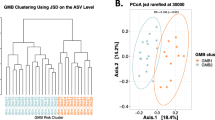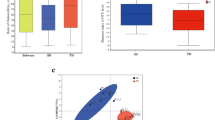Abstract
Bacterial flora has clinical significance for the host. The metabolic environment created by this flora influences immunotherapy in urothelial carcinoma. However, there are no reports on the clinical significance of bacterial flora in the host bloodstream. We aimed to clarify the correlation between extracellular vesicle (EV)-derived blood microflora information and tumor immunological status in urothelial carcinoma (UC) patients. Serum samples were collected from 20 healthy donors, 50 patients with localized UC, and 31 patients with metastatic UC (mUC) who had undergone pembrolizumab treatment. Bacterial DNA in EVs was extracted from each sample. Metagenomic sequencing was performed after amplification of the V1–V2 region of the bacterial 16S rRNA gene. Using the matched tumor tissue and serum samples, we revealed that the smaller amount of peripheral EVs carrying Firmicutes DNA was significantly correlated with the higher number of infiltrating T cells within tumor tissues (CD3; p = 0.015, CD4; p = 0.039, CD8; p = 0.0084) and the higher expression of activation markers on their surface (ICOS on both CD4; p = 0.0013 and CD8 T cells; p = 0.016 and 4-1BB on CD4 T cells; p = 0.016). In terms of circulating metabolic information, l-Ser and l-Pro levels, which play important roles in T cell expansion and proliferation, were significantly higher in the Firmicutes-low group (p = 0.010). All of the patients with higher Firmicutes abundance had disease progression without any clinical response (p = 0.026) and significantly inferior prognosis for pembrolizumab therapy (p = 0.035). This is the first study on the importance of peripheral bacterial EVs in cancer patients treated with cancer immunotherapy.





Similar content being viewed by others
Data availability
The data generated in this study are available within the article and its supplementary data files.
References
Nadal R, Bellmunt J (2019) Management of metastatic bladder cancer. Cancer Treat Rev 76:10–21. https://doi.org/10.1016/j.ctrv.2019.04.002
Kawashima A, Kanazawa T, Jingushi K et al (2019) Phenotypic analysis of tumor tissue-infiltrating lymphocytes in tumor microenvironment of bladder cancer and upper urinary tract carcinoma. Clin Cancer 17:114–124. https://doi.org/10.1016/j.clgc.2018.11.004
Kalluri R, LeBleu VS (2020) The biology, function, and biomedical applications of exosomes. Sci 367:6478. https://doi.org/10.1126/science.aau6977
Stentz R, Carvalho AL, Jones EJ, Carding SR (2018) Fantastic voyage: the journey of intestinal microbiota-derived microvesicles through the body. Biochem Soc Trans 46:1021–1027. https://doi.org/10.1042/BST20180114
Tulkens J, De Wever O, Hendrix A (2020) Analyzing bacterial extracellular vesicles in human body fluids by orthogonal biophysical separation and biochemical characterization. Nat Protoc 15:40–67. https://doi.org/10.1038/s41596-019-0236-5
Chen C, Song X, Wei W et al (2017) The microbiota continuum along the female reproductive tract and its relation to uterine-related diseases. Nat Commun 8:875. https://doi.org/10.1038/s41467-017-00901-0
Lundy SD, Sangwan N, Parekh NV et al (2021) Functional and taxonomic dysbiosis of the gut, urine, and semen microbiomes in male infertility. Eur Urol 79:826–836. https://doi.org/10.1016/j.eururo.2021.01.014
Miyauchi E, Kim SW, Suda W et al (2020) Gut microorganisms act together to exacerbate inflammation in spinal cords. Nat 585:102–106. https://doi.org/10.1038/s41586-020-2634-9
Park SY, Hwang BO, Lim M et al (2021) Oral-gut microbiome axis in gastrointestinal disease and cancer. Cancers (Basel) 13:2124. https://doi.org/10.3390/cancers13092124
Saito T, Nishikawa H, Wada H et al (2016) Two FOXP3(+)CD4(+) T cell subpopulations distinctly control the prognosis of colorectal cancers. Nat Med 22:679–684. https://doi.org/10.1038/nm.4086
Matsushita M, Fujita K, Hayashi T et al (2021) Gut microbiota-derived short-chain fatty acids promote prostate cancer growth via IGF1 signaling. Cancer Res 81:4014–4026. https://doi.org/10.1158/0008-5472.CAN-20-4090
Hopkins AM, Kichenadasse G, Karapetis CS, Rowland A, Sorich MJ (2020) Concomitant antibiotic use and survival in urothelial carcinoma treated with atezolizumab. Eur Urol 78:540–543. https://doi.org/10.1016/j.eururo.2020.06.061
Mager LF, Burkhard R, Pett N et al (2020) Microbiome-derived inosine modulates response to checkpoint inhibitor immunotherapy. Sci 369:1481–1489. https://doi.org/10.1126/science.abc3421
Pederzoli F, Bandini M, Raggi D et al (2021) Is there a detrimental effect of antibiotic therapy in patients with muscle-invasive bladder cancer treated with neoadjuvant pembrolizumab? Eur Urol 80:319–322. https://doi.org/10.1016/j.eururo.2021.05.018
Routy B, Le Chatelier E, Derosa L et al (2018) Gut microbiome influences efficacy of PD-1-based immunotherapy against epithelial tumors. Sci 359:91–97. https://doi.org/10.1126/science.aan3706
Kalaora S, Nagler A, Nejman D et al (2021) Identification of bacteria-derived HLA-bound peptides in melanoma. Nat 592:138–143. https://doi.org/10.1038/s41586-021-03368-8
Nejman D, Livyatan I, Fuks G et al (2020) The human tumor microbiome is composed of tumor type-specific intracellular bacteria. Sci 368:973–980. https://doi.org/10.1126/science.aay9189
Poore GD, Kopylova E, Zhu Q et al (2020) Microbiome analyses of blood and tissues suggest cancer diagnostic approach. Nat 579:567–574. https://doi.org/10.1038/s41586-020-2095-1
Edge SB, Committee American Joint, on Cancer, (2010) AJCC cancer staging manual, 7th edn. Springer, New York
Moriyama K, Ando C, Tashiro K et al (2008) Polymerase chain reaction detection of bacterial 16S rRNA gene in human blood. Microbiol Immunol 7:375–382. https://doi.org/10.1111/j.1348-0421.2008.00048.x
Afgan E, Baker D, Batut B et al (2018) The Galaxy platform for accessible, reproducible and collaborative biomedical analyses: 2018 update. Nucleic Acids Res 46:W537–W544. https://doi.org/10.1093/nar/gky379
Hesaka A, Sakai S, Hamase K, Ikeda T, Matsui R, Mita M, Horio M, Isaka Y, Kimura T (2019) D-Serine reflects kidney function and diseases. Sci Rep 9:5104. https://doi.org/10.1038/s41598-019-41608-0
Kawashima A, Yamamoto Y, Sato M et al (2021) FAN score comprising fibrosis-4 index, albumin-bilirubin score and neutrophil-lymphocyte ratio is a prognostic marker of urothelial carcinoma patients treated with pembrolizumab. Sci Rep 11:21199. https://doi.org/10.1038/s41598-021-00509-x
Ley RE, Turnbaugh PJ, Klein S, Gordon JI (2006) Microbial ecology: Human gut microbes associated with obesity. Nat 444:1022–1023. https://doi.org/10.1038/4441022a
Turnbaugh PJ, Ley RE, Mahowald MA, Magrini V, Mardis ER, Gordon JI (2006) An obesity-associated gut microbiome with increased capacity for energy harvest. Nat 444:1027–1031. https://doi.org/10.1038/nature05414
Liang D, Leung RK, Guan W, Au WW (2018) Involvement of gut microbiome in human health and disease: Brief overview, knowledge gaps and research opportunities. Gut Pathog 10:3. https://doi.org/10.1186/s13099-018-0230-4
Ma EH, Bantug G, Griss T et al (2017) Serine is an essential metabolite for effector T cell expansion. Cell Metab 25:482. https://doi.org/10.1016/j.cmet.2017.01.014
Wu J, Li G, Li L, Li D, Dong Z, Jiang P (2021) Asparagine enhances LCK signalling to potentiate CD8(+) T-cell activation and anti-tumour responses. Nat Cell Biol 23:75–86. https://doi.org/10.1038/s41556-020-00615-4
Chu TL, Guan Q, Nguan CY, Du C (2013) Halofuginone suppresses T cell proliferation by blocking proline uptake and inducing cell apoptosis. Int Immunopharmacol 16:414–423. https://doi.org/10.1016/j.intimp.2013.04.031
Boussiotis VA (2016) Molecular and biochemical aspects of the PD-1 checkpoint pathway. N Engl J Med 375:1767–1778. https://doi.org/10.1056/NEJMra1514296
Flores-Toro JA, Luo D, Gopinath A et al (2020) CCR2 inhibition reduces tumor myeloid cells and unmasks a checkpoint inhibitor effect to slow progression of resistant murine gliomas. Proc Natl Acad Sci USA 117:1129–1138. https://doi.org/10.1073/pnas.1910856117
Nagase H, Takeoka T, Urakawa S et al (2017) ICOS(+) Foxp3(+) TILs in gastric cancer are prognostic markers and effector regulatory T cells associated with helicobacter pylori. Int J Cancer 140:686–695. https://doi.org/10.1002/ijc.30475
Urakawa S, Yamasaki M, Makino T et al (2021) The impact of ICOS(+) regulatory T cells and Helicobacter pylori infection on the prognosis of patients with gastric and colorectal cancer: potential prognostic benefit of pre-operative eradication therapy. Cancer Immunol Immunother 70:443–452. https://doi.org/10.1007/s00262-020-02696-4
Oh DY, Kwek SS, Raju SS et al (2020) Intratumoral CD4(+) T cells mediate anti-tumor cytotoxicity in human bladder cancer. Cell 181:1612–25.e13. https://doi.org/10.1016/j.cell.2020.05.017
Kato R, Yamasaki M, Urakawa S et al (2018) Increased Tim-3(+) T cells in PBMCs during nivolumab therapy correlate with responses and prognosis of advanced esophageal squamous cell carcinoma patients. Cancer Immunol Immunother 67:1673–1683. https://doi.org/10.1007/s00262-018-2225-x
Ianiro G, Rossi E, Thomas AM et al (2020) Faecal microbiota transplantation for the treatment of diarrhoea induced by tyrosine-kinase inhibitors in patients with metastatic renal cell carcinoma. Nat Commun 11:4333. https://doi.org/10.1038/s41467-020-18127-y
Li S, Jiang W, Zheng C et al (2020) Oral delivery of bacteria: basic principles and biomedical applications. J Control Release 327:801–833. https://doi.org/10.1016/j.jconrel.2020.09.011
David LA, Materna AC, Friedman J, Campos-Baptista MI, Blackburn MC, Perrotta A, Erdman SE, Alm EJ (2014) Host lifestyle affects human microbiota on daily timescales. Gen Biol 15:R89. https://doi.org/10.1186/gb-2014-15-7-r89
Desai MS, Seekatz AM, Koropatkin NM et al (2016) A dietary fiber-deprived gut microbiota degrades the colonic mucus barrier and enhances pathogen susceptibility. Cell 167:1339–53.e21. https://doi.org/10.1016/j.cell.2016.10.043
Marshall WF, Young KD, Swaffer M et al (2012) What determines cell size? BMC Biol 10:101. https://doi.org/10.1186/1741-7007-10-101
Chronopoulos A, Kalluri R (2020) Emerging role of bacterial extracellular vesicles in cancer. Oncogene 39:6951–6960. https://doi.org/10.1038/s41388-020-01509-3
Funding
Japan Society for the Promotion of Science Grants-in-Aid for Scientific Research (C) (19K09709 awarded to AK); and the Suzuki Urological Foundation in Japan (awarded to AK).
Author information
Authors and Affiliations
Contributions
Conceptualization was done by KJ, AK, and TS, Methodology was done by KJ, AK, TK, DM, TK, MM, AY, TU, GY, KO, YK, ET, and MU; Investigation was done by KJ, AK, and TS; Visualization was done by KJ and AK; Funding acquisition was don by KJ, AK, HW, and NN; Project administration was done by AK; Supervision was done by KT, HW, and NN; Writing—original draft were done by KJ and AK; Writing—review and editing were done by KJ, AK, TS, TK, MM, KT, HW, and NN. All authors read and approved the final manuscript.
Corresponding author
Ethics declarations
Conflict of interest
The authors declare that they have no conflicting interest.
Ethical approval
The study was approved by the ethics review board of both the Osaka University Medical Hospital (#13397–2, #14069–3).
Consent to participate
Informed consent was obtained from all individual participants included in the study.
Consent to publish
Not applicable.
Additional information
Publisher's Note
Springer Nature remains neutral with regard to jurisdictional claims in published maps and institutional affiliations.
Supplementary Information
Below is the link to the electronic supplementary material.
Rights and permissions
About this article
Cite this article
Jingushi, K., Kawashima, A., Saito, T. et al. Circulating extracellular vesicles carrying Firmicutes reflective of the local immune status may predict clinical response to pembrolizumab in urothelial carcinoma patients. Cancer Immunol Immunother 71, 2999–3011 (2022). https://doi.org/10.1007/s00262-022-03213-5
Received:
Accepted:
Published:
Issue Date:
DOI: https://doi.org/10.1007/s00262-022-03213-5




